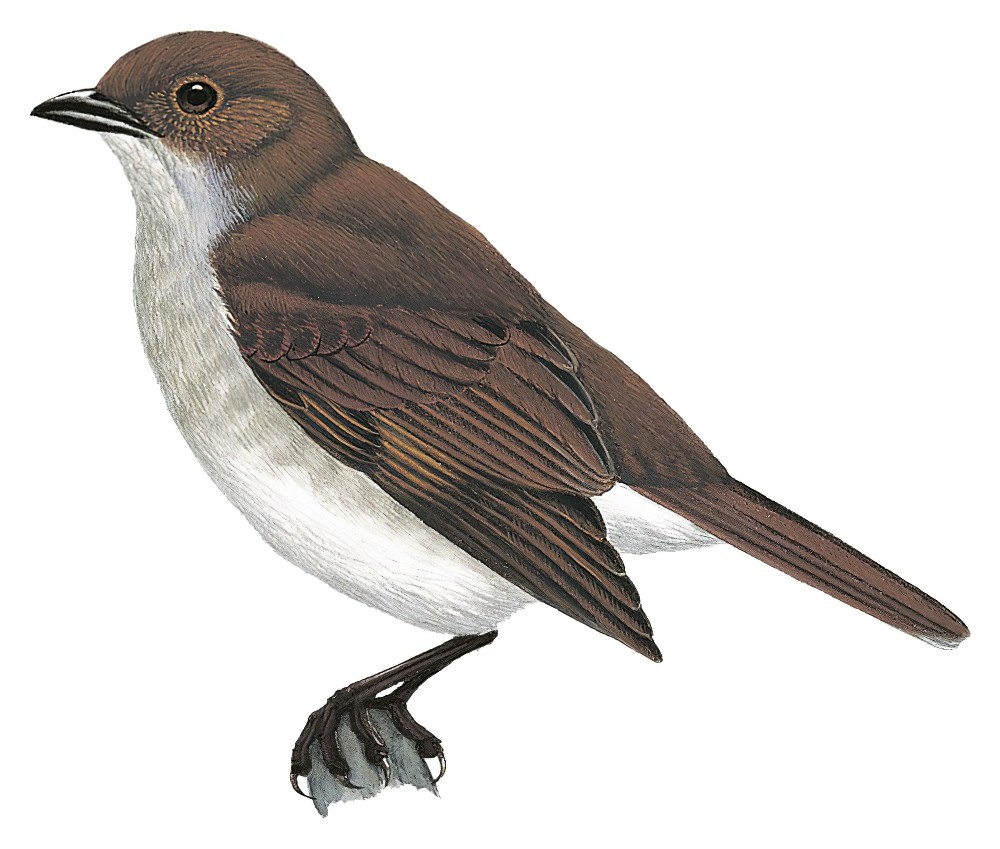Kamao / Myadestes myadestinus

Kamao
SCI Name:
Protonym: Phaeornis myadestina Proc.U.S.Natl.Mus. 10 p.90
Taxonomy: Passeriformes / Turdidae / Myadestes
Taxonomy Code: kamao
Type Locality: Kauai Island, Hawaiian Archipelago.
Author: Stejneger
Publish Year: 1887
IUCN Status: Extinct
DEFINITIONS
MYADESTES
(Turdidae; Ϯ Rufous-throated Solitaire M. genibarbis) Gr. μυα mua fly < μυια muia, μυιας muias fly; εδεστης edestēs eater < εδω edō to eat; "MYADESTES; we shall not only characterize this form, but endeavour to demonstrate it as the rasorial type of Rhipidura. The bill is small, angular, and much depressed towards the base; but the culmen is slightly and gradually bent, and the gonys ascends, in the same degree, towards the point: the rictal bristles are few and short, and do not extend to one-half the length of the bill: the wings are moderate, not reaching beyond the tail-covers; their structure is the same as in all the Old World flycatchers, but the first and second are suddenly narrowed at their tips; a character we have not met with in any other of this family. The legs, for a flycatcher, are strong, the tarsus moderately lengthened, and the toes considerably developed, much longer, in fact, than either in Rhipidura or Leucocirca. The middle toe is as long as the tarsus; the inner toe much shorter than the outer, but both are cleft to their base; the hinder and inner toes are equal; the legs are very pale, and the tarsal scale is in one entire piece; the breadth and curvature of the claws, joined to the relative length of the toes, renders it highly probable that this bird does not habitually frequent the ground. But its great peculiarity lies in the tail, which is moderately lengthened and slightly graduated, having something of the size and form of Leucocirca, excepting that the feathers, instead of being broad, are rather narrow, with the tips acuminated. Such are the characters of the bird before us. It is at once distinguished from our sub-genus Muscicapa (as subsequently defined) by its long toes and lengthened graduated bill; and from Leucocirca, by its small slightly bristled bill, and those other indications which unite it to the genuine flycatchers; the whole structure of the bird, particularly in the head, which is thick like that of the robin, is quite opposed to that slenderness of shape so general among its congeners. Lastly, although not one of the leastof its characteristic marks, is the pure white which ornaments the ends of the three pair of lateral tail-feathers. ... WHISKERED FANTAIL. Myidestes genibarbis, SWAINS. ... We are entirely unacquainted with the country it inhabits, and, of course, are equally so regarding its manners. Judging from the formation of its wings, however, we should conclude it was from some part of the warm latitudes of Africa or India ... it bears upon its face a flycatcher disguised as a robin." (Swainson 1838); "Myadestes Swainson, 1838, Nat. Libr. Flycatchers, p. 132. Type, by monotypy, Myidestes (sic) genibarbis Swainson." (Ripley in Peters 1964, X, 89).
Var. Myiadectes (Gr. μυια muia, μυιας muias fly; δεκτης dektēs receiver < δεχομαι dekhomai to receive), Myiadestes, Myiesthes, Myedestes, Myidestes, Myidastes, Myiedestes, Myiodectes.
Synon. Phaeornis.
myadestinus
Genus Myadestes Swainson, 1838, solitaire; L. suffix -inus pertaining to; "And, in fact, nobody can help being struck by the great similarity between Phæornis myadestina and, say, Myadestes obscurus, a similarity first pointed out to me by friend Ridgway" (Stejneger 1887) (‡Myadestes).
UPPERCASE: current genus
Uppercase first letter: generic synonym
● and ● See: generic homonyms
lowercase: species and subspecies
●: early names, variants, mispellings
‡: extinct
†: type species
Gr.: ancient Greek
L.: Latin
<: derived from
syn: synonym of
/: separates historical and modern geographic names
ex: based on
TL: type locality
OD: original diagnosis (genus) or original description (species)












